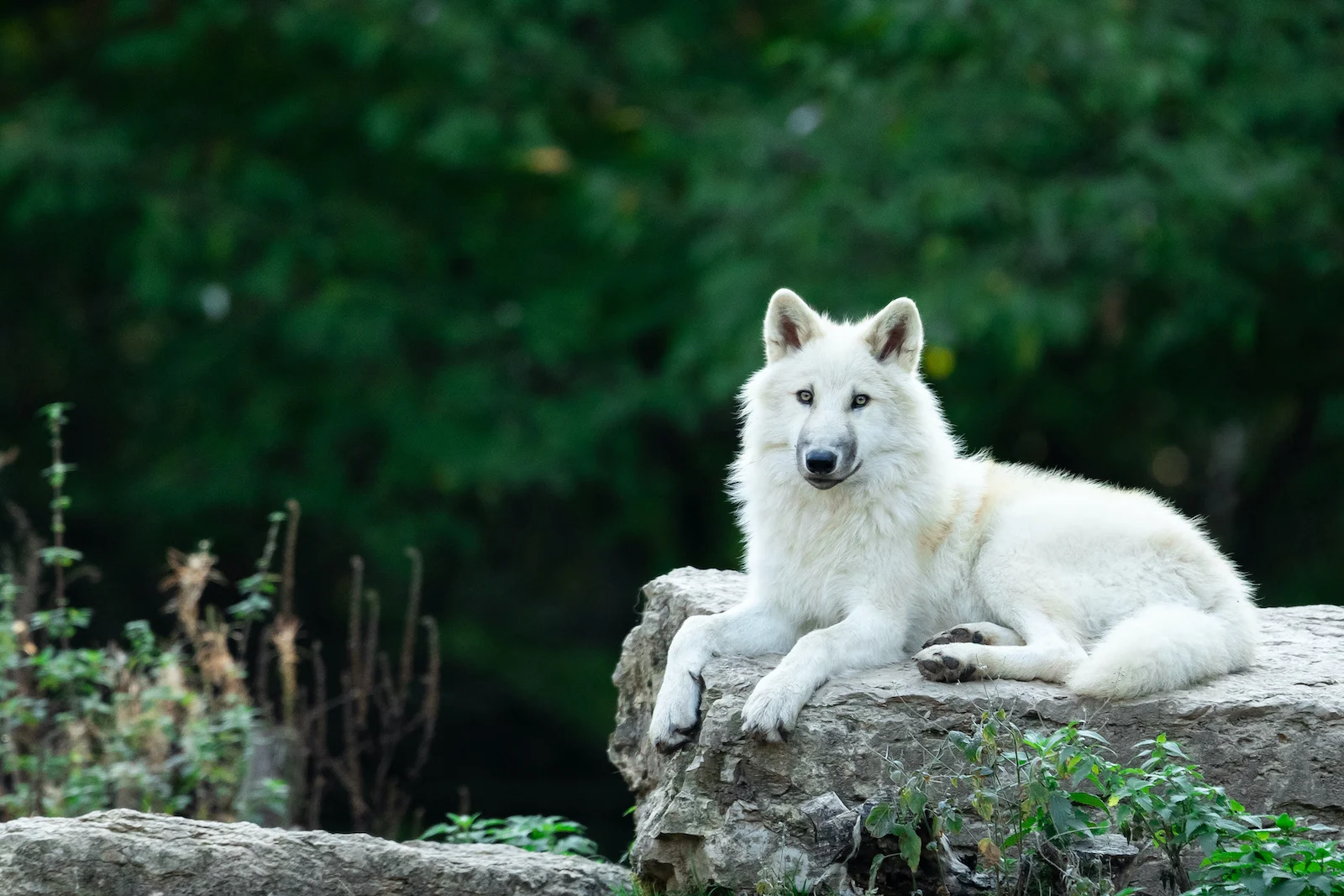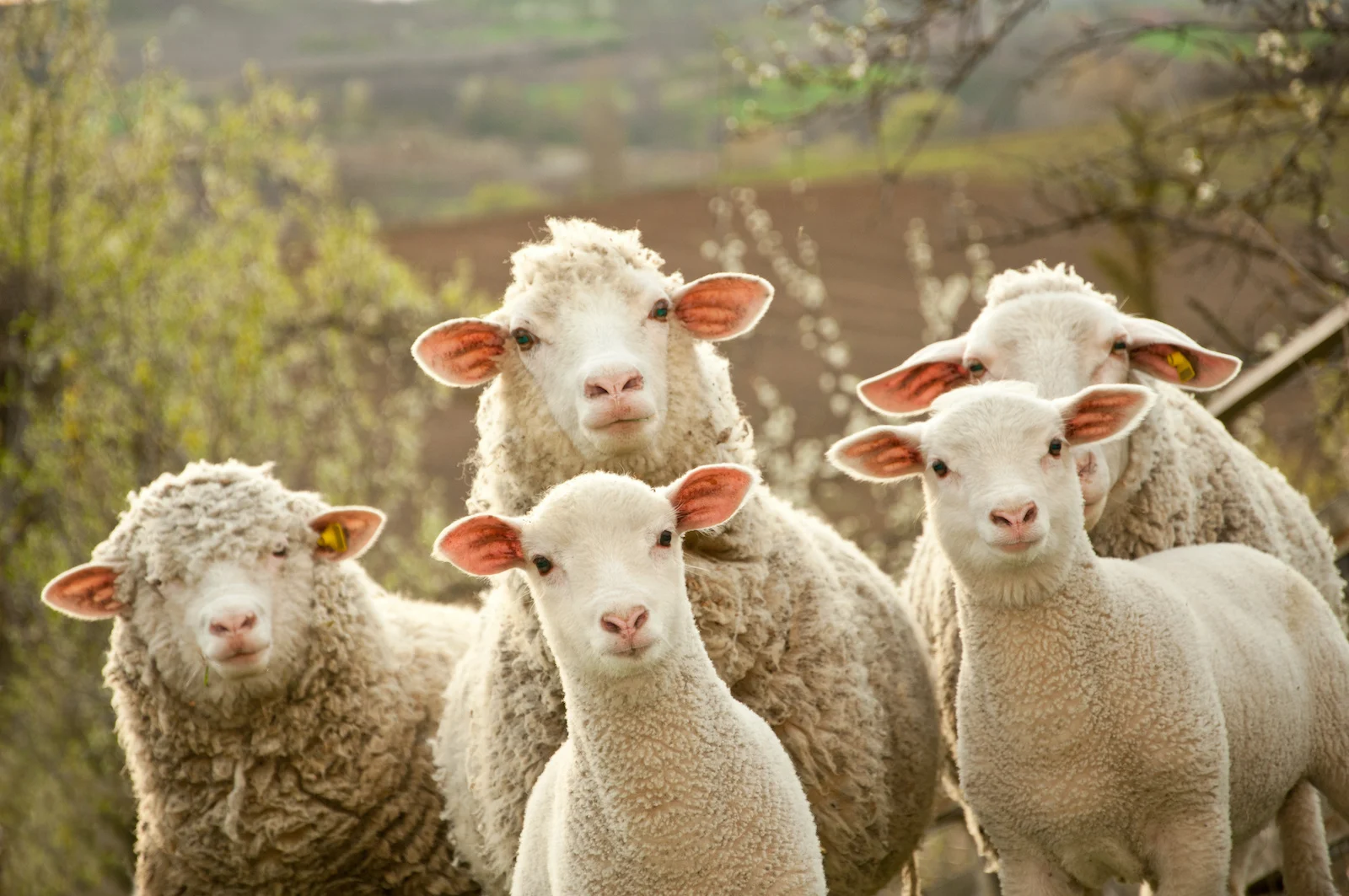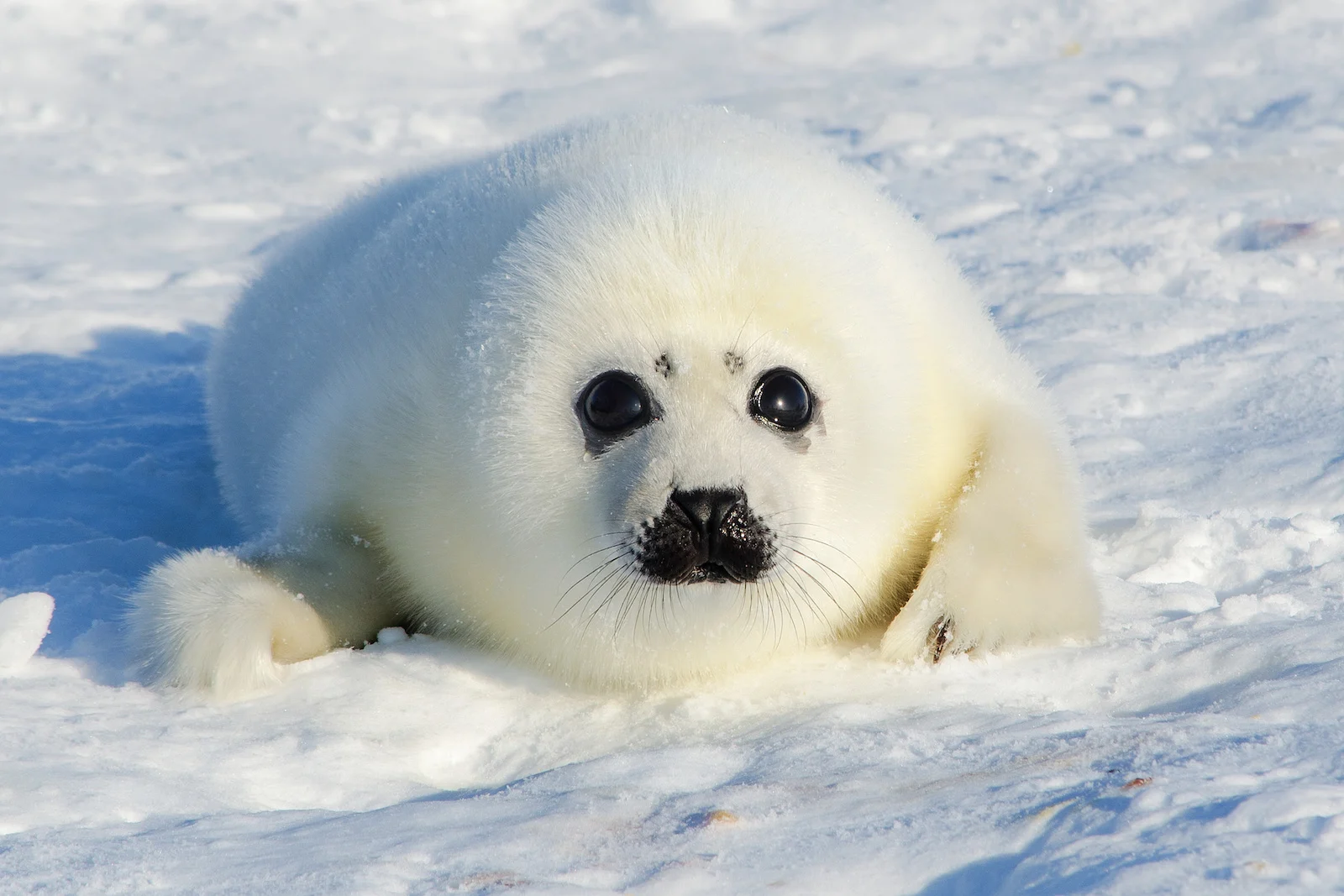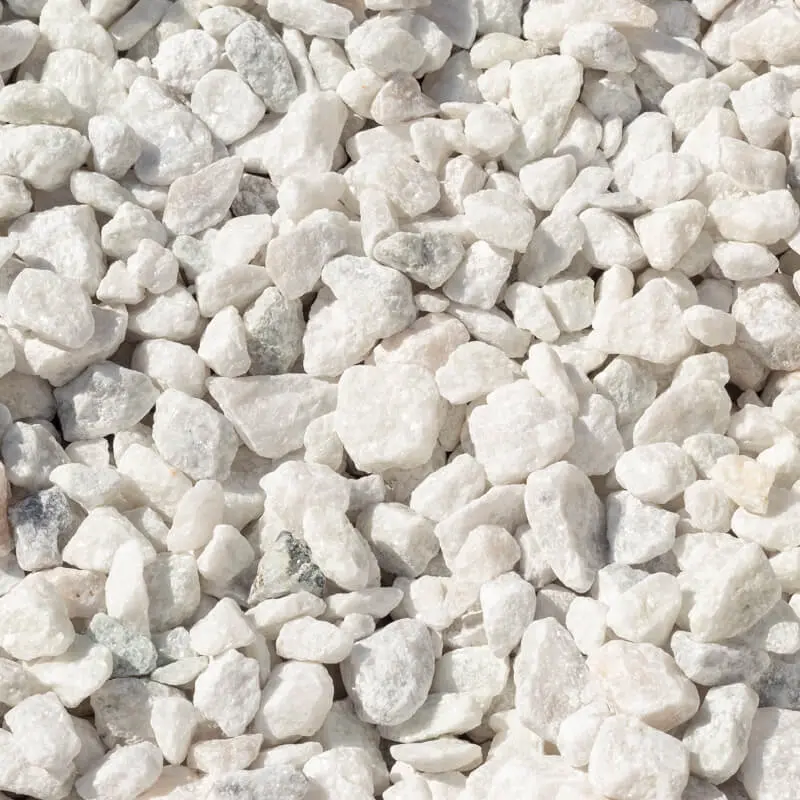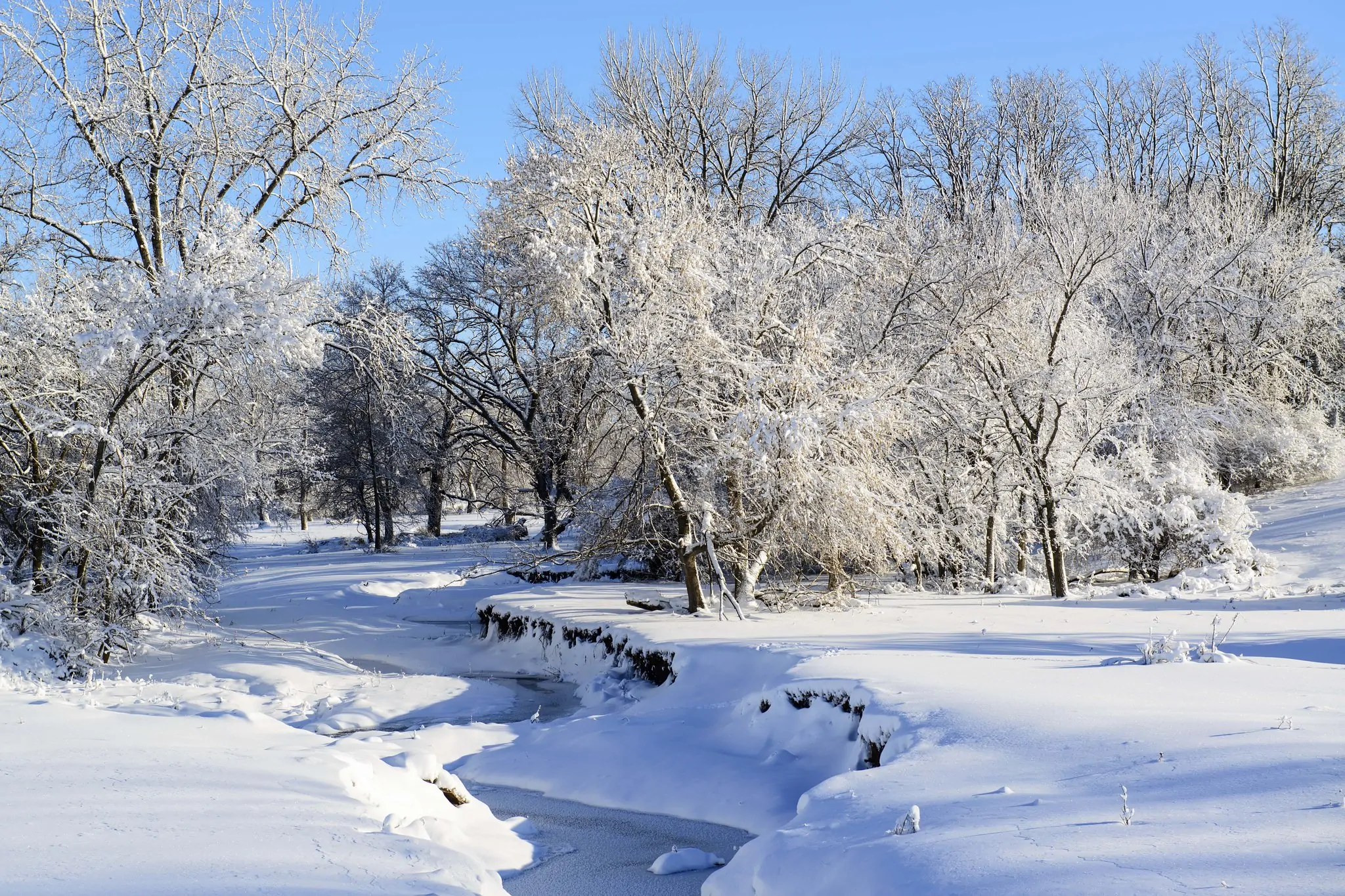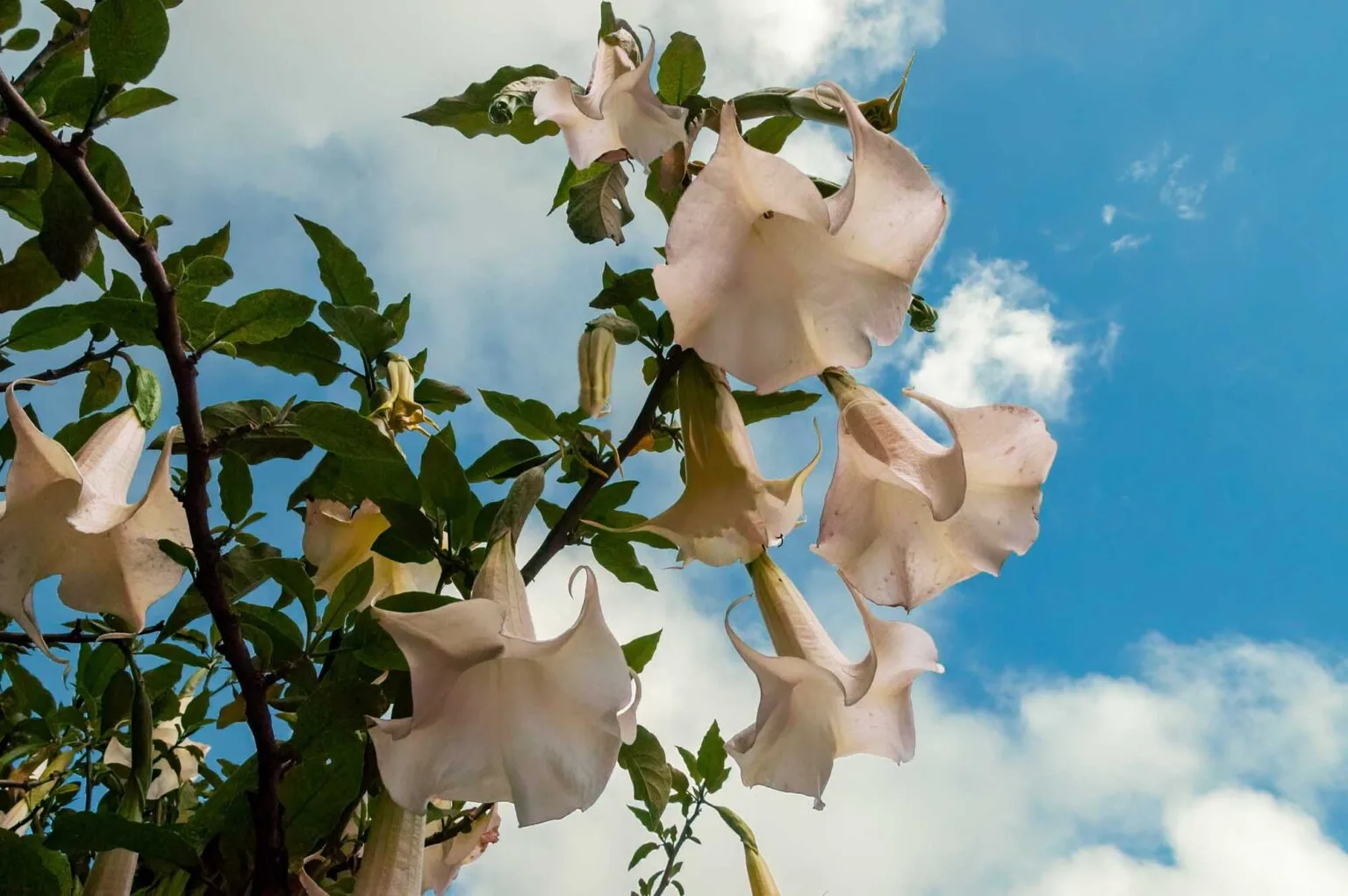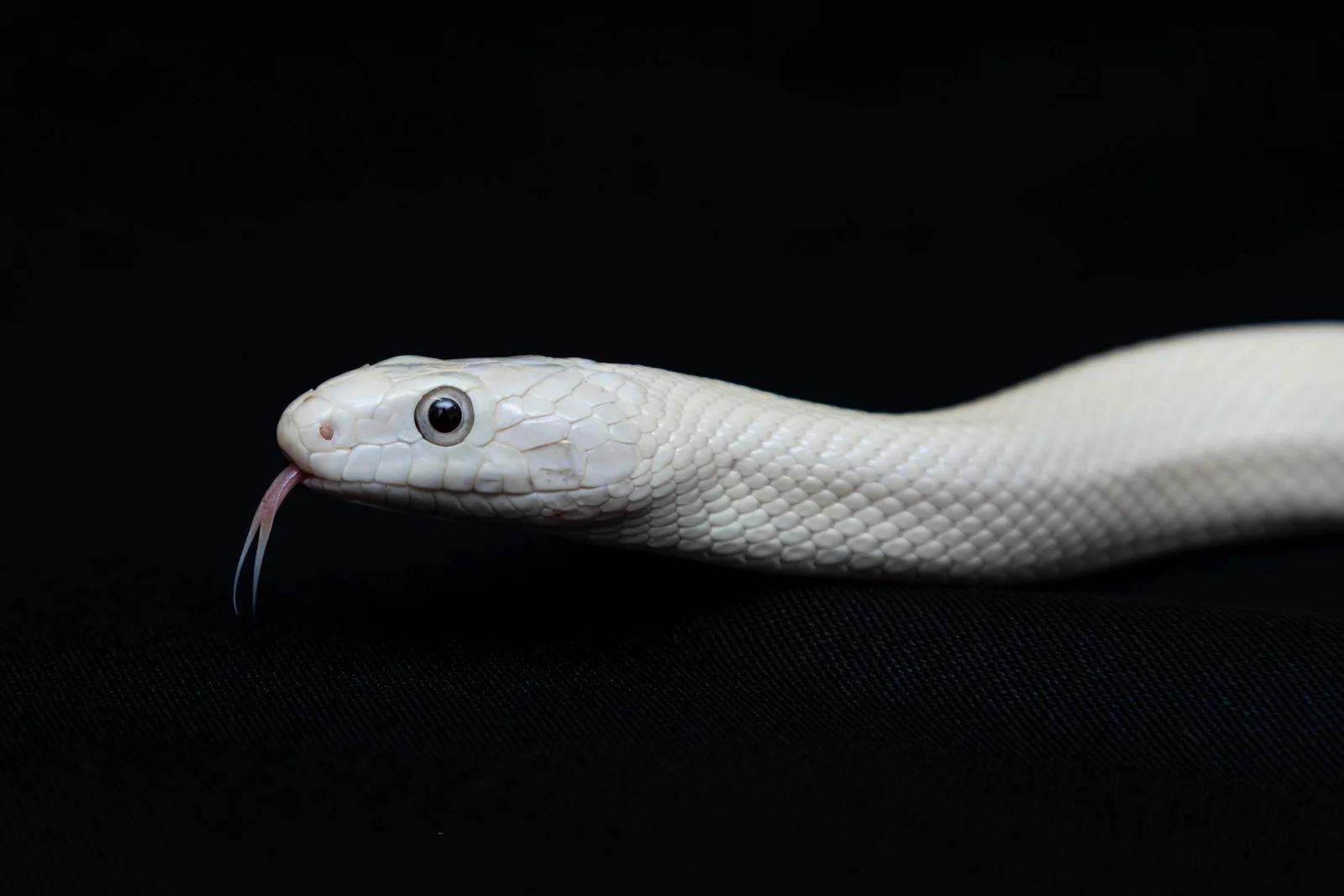White is a cool and calm color that shows up in lots of places in nature. It’s the color of snow, fluffy clouds, and some really pretty flowers. In this blog post, we’re going to check out 50 things in nature that are white. From the soft feathers of a swan to the hard shell of an egg, white things are all around us, each with its own special look and story.
As we talk about each white thing, you’ll see how special and different they can be. Some are things we see every day, while others are rare and exciting to learn about. Whether it’s an animal, a plant, or something else, every white thing in nature has something cool to share. So, let’s get started and explore all these amazing white wonders together.
1. Arctic Wolf
The Arctic Wolf, also known as the white wolf, lives in the very cold parts of North America and Greenland. Its white fur helps it blend in with the snow and keeps it warm in freezing temperatures. Unlike other wolves, Arctic Wolves often don’t see trees or humans in their lifetime, living in places too cold for both.
2. Beluga Whale
The Beluga Whale is a small, white whale found in Arctic and sub-Arctic waters. Its white color and round forehead make it easily recognizable. Belugas can change the shape of their bulbous forehead, known as a “melon,” which helps with their echolocation, a way of finding things by bouncing sound off objects.
3. Clouds
Clouds are collections of tiny water droplets or ice crystals floating in the sky. They form when water vapor in the air cools and condenses on tiny particles like dust. The reason clouds are white is because the water droplets or ice crystals scatter all colors of light, combining to make white light.
4. Swan
Swans are large, graceful birds known for their long necks and white feathers, although some species can be black or mixed. They are often found in lakes, rivers, and wetlands. Swans are monogamous, typically forming lifelong bonds with their partners, and are known for their aggressive protection of their nests.
5. Coconut
The coconut is a tropical fruit known for its large, hard shell and the white, edible meat inside, surrounded by a layer of water. It grows on the coconut palm, a tree that thrives in tropical climates around the world. Coconuts are unique because they can float and travel across oceans, helping them spread to different islands and continents.
6. Fantail Pigeon
The Fantail Pigeon is a special kind of pigeon with a big, fan-like tail. It has more feathers in its tail than a normal pigeon. People like them because they look unique and beautiful. They came from India and are now kept mostly for fun, not for sending messages or racing. Even with their big tails, they can still fly, just not as fast as other pigeons.
7. White Horse
The White Horse is not just any horse with a light coat; true white horses have a pure white coat from birth and keep this color throughout their life. They have pink skin under their white fur and often have blue or brown eyes. This color is rare and results from specific genetic traits that prevent the horse’s coat from having any color.
8. Glaciers
Glaciers are massive, slow-moving rivers of ice that form when snow accumulates over years, compresses, and turns into ice. Found in mountain ranges and polar regions around the world, they play a crucial role in the Earth’s freshwater supply. Despite their solid appearance, glaciers are dynamic and can flow like very slow rivers.
9. Heliotrope Flowers
Heliotrope flowers are sweet-smelling, with purple or white blooms that bees and butterflies love. They are thought to follow the sun, which is how they got their name, but that’s more of a myth. These flowers come from Peru and are great for gardens because they smell good and bloom a lot.
10. Daisy Flowers
Daisy flowers are known for their simple beauty, featuring white petals around a bright yellow center, though they can come in other colors too. They are part of a large family of plants and are found almost everywhere in the world. Daisies are special because they actually consist of two types of flowers combined: the white petals are individual flowers, and the yellow center is made up of another group of flowers.
11. Pearl
Pearls are precious gems formed inside the shells of certain mollusks, like oysters and mussels, as a defense against irritants such as a piece of sand. The mollusk secretes layers of nacre, a lustrous substance, around the irritant, creating a pearl over time. Unlike most gems mined from the earth, pearls are unique because they are formed by living creatures.
12. Peace Lilies
Peace Lilies are popular indoor plants, known for their glossy green leaves and striking white flowers, which aren’t true flowers but a special leaf bract that surrounds a cream-colored spadix. They thrive in low light and are easy to care for, making them a favorite for home and office spaces.
13. Sheep
Sheep are domesticated animals known for their woolly coats, which can range from white to shades of brown, black, and even multicolored. They have been raised by humans for thousands of years for wool, meat, and milk. Sheep are social animals, preferring to stay in flocks, and can recognize individual faces, both sheep and human, for years.
14. Garlic
Garlic is a popular seasoning worldwide, known for its strong flavor and aroma. It’s part of the onion family, which also includes shallots and leeks. People have used garlic not only for cooking but also for its health benefits, such as boosting the immune system and reducing heart disease risks.
15. White Cattle
White Cattle, including breeds like the British White and Charolais, are known for their distinctive white or cream-colored coats. These breeds are often raised for their meat, which is valued for its quality and taste. They are adapted to various climates and environments, making them versatile in different farming practices.
16. Jasmine
Jasmine is a fragrant flower known for its sweet aroma and delicate white petals, though some species may have yellow flowers. It belongs to the olive family and is native to tropical and warm temperate regions. Jasmine is highly valued in perfumery and tea-making, with its scent being a popular ingredient in fragrances and its dried flowers used to flavor jasmine tea.
17. Dwarf Hotot Rabbit
The Dwarf Hotot rabbit is a small pet known for its white fur and unique black circle around its eyes like it’s wearing eyeliner. It comes from Germany, is easy to take care of, and is very friendly, making it great for families. This rabbit is playful and needs some space to move around. It got its special look from being bred on purpose to mix the looks of bigger Hotot rabbits with smaller ones.
18. Cattle Egret
The Cattle Egret is a small white bird that often lives near cows and other large animals, eating the insects that these animals stir up as they move. Originally from Africa and Asia, it has spread worldwide, adapting well to various environments. Unlike other egrets, it spends more time in fields than in water.
19. White Rat
The White Rat, often referred to as the albino rat due to its lack of pigmentation, is a domesticated variety of the brown rat. These rats have white fur and red or pink eyes, characteristics of albinism. They are popular as pets and are widely used in scientific research because of their intelligence, docility, and adaptability to living in captivity.
20. White Nudibranch Animal
The White Nudibranch is a type of sea slug known for its striking white color, often adorned with patterns or spots of different colors depending on the species. Nudibranchs are celebrated for their vivid appearances and are found in oceans worldwide. These creatures are soft-bodied and lack a shell, making their bright colors and intricate designs a form of defense against predators, signaling toxicity or a foul taste.
21. Giant Gourami
The Giant Gourami is a big fish from Southeast Asia that can grow up to 28 inches long. It’s silver-white and liked for ponds and big fish tanks because it’s calm and can live in different water types. A cool thing about it is that it can breathe air from the surface, thanks to a special organ, which helps it survive in water with not much oxygen. It eats both plants and small creatures, making it easy to feed.
22. Harp Seal
The Harp Seal is a marine mammal found in the cold waters of the North Atlantic and Arctic Oceans. Known for their white fur as pups, which helps them blend in with the ice, adults have a distinctive black and gray pattern with a harp-shaped mark on their back. Harp Seals are social animals, forming large groups on ice floes during breeding season.
23. Ivory Gull
The Ivory Gull is a small, striking bird with pure white feathers, found in the high Arctic regions. It’s known for its bright red legs and black eyes, which contrast sharply against its plumage. These gulls are among the most northerly breeding birds, often seen near icebergs and cold seas where they feed on fish and crustaceans.
24. Japanese Rice Fish
The Japanese Rice Fish, also known as Medaka, is a small, hardy freshwater fish native to East Asia. It’s notable for its translucent body and the ability to adapt to various water conditions, making it a popular choice for aquarium enthusiasts. These fish are often found in rice paddies, hence their name, thriving in both fresh and brackish water.
25. White Goose
The White Goose is a domesticated bird, known for its bright white feathers and orange bill and feet. Geese are raised for various purposes, including meat, eggs, and down feathers, and are also kept as pets or for ornamental purposes due to their attractive appearance. White Geese are social animals, often seen in flocks, and can be quite vocal, especially when threatened or during mating season.
26. Dandelion
The Dandelion is a common wildflower, easily recognized by its bright yellow flowers and fluffy white seed heads, often called “blowballs” or “clocks.” Found in many parts of the world, it thrives in lawns, gardens, and wild areas, sometimes considered a weed. Dandelions are fully edible, from their roots to the flowers, and have been used in traditional medicine for centuries
27. White Feather
A white feather symbolizes different things across cultures, often standing for peace, purity, or innocence. In nature, white feathers come from birds and are found in a variety of shapes and sizes, each serving different functions like insulation, flight, or camouflage.
28. Penguins
Penguins are birds that can’t fly but are great swimmers. They have black and white feathers that help them hide from predators in the water. Most live in the Southern Hemisphere, but one kind lives near the equator. Penguins like to be together, especially when they have babies or find food.
29. White Roses
White roses symbolize purity, innocence, and new beginnings, making them a popular choice for weddings and other ceremonies. These flowers stand out for their elegant appearance and fragrant blooms. They come in various shades of white, from pure white to creamy hues.
30. Chickens
Chickens are domesticated birds kept worldwide for their eggs and meat. They come in a variety of breeds, sizes, and colors, including white. Chickens are social animals, living in flocks with a complex social structure known as a “pecking order.” They can recognize over 100 different faces of their kind and even show empathy for each other.
31. White Mushrooms
White mushrooms, also known as button mushrooms, are one of the most commonly consumed mushrooms around the world. They have a mild taste that becomes more pronounced when cooked, making them a versatile ingredient in many dishes. These mushrooms are actually the immature form of the Agaricus bisporus species, which can also develop into brown cremini and portobello mushrooms as they mature.
32. White Marble Stones
White marble is a highly valued rock, known for its pure white appearance and beautiful, intricate veining. It’s been used for centuries in sculpture and architecture, symbolizing purity and immortality. White marble forms when limestone is subjected to high pressure and temperature, transforming its crystals. This process, called metamorphism, creates the dense, sparkling texture that marble is famous for.
33. Snow
Snow is frozen precipitation that forms in clouds when water vapor freezes into ice crystals. These crystals stick together in the air, falling to the ground as snowflakes, each with a unique, intricate pattern. Snow is common in cold climates and during the winter season in temperate zones.
34. Cotton
Cotton is a natural fiber that comes from the cotton plant, specifically from around the seeds of the plant. It’s known for being soft, breathable, and highly absorbent, making it a favorite material for clothing, towels, and bed linens. Cotton grows in fluffy balls that are harvested and then spun into yarn or thread.
35. White Angel Trumpet Flowers
White Angel Trumpet flowers are large, sweet-smelling, and hang down like trumpets. They grow in warm places and look very pretty in gardens. However, they are poisonous if eaten, so they need to be handled carefully. These flowers are great for adding a dramatic look, but remember to keep them away from pets and kids.
36. Cauliflower
Cauliflower is a vegetable that’s part of the cabbage family, known for its white, edible head, which is a mass of undeveloped flower buds. It’s versatile in cooking and used in everything from raw salads to baked dishes. Cauliflower is rich in vitamins and minerals, including vitamins C and K, and has compounds that may help reduce the risk of some diseases.
37. White Tiger
The White Tiger is a rare pigmentation variant of the Bengal tiger, characterized by its striking white fur and black stripes. This coloration is the result of a genetic mutation affecting the pigmentation of the tiger’s fur. White Tigers are not a separate species but rather the same as any other tiger, with the only difference being their coat color. They have been a subject of fascination and are often featured in zoos and wildlife parks.
38. Calla-Lilly
The Calla Lily is a sleek flower that looks like a trumpet. It’s not just white; it can also be yellow, pink, green, purple, or black. These flowers are like wet soil and can grow outside or in pots. They’re not real lilies but are related to peace lilies. Calla Lilies are loved for their simple beauty and are often used in bouquets to show purity or to say “I’m sorry.”
39. White Cap Sea
The term “white cap” in the context of the sea refers to the white, frothy waves that appear on the surface of the water when the wind is strong enough to cause the waves to crest and break. These white caps are a common sight in oceans, seas, and even large lakes during windy conditions. The formation of white caps is an indication of the sea’s energy and can serve as a warning sign to mariners about rough and potentially dangerous sea conditions.
40. Samoyed Dog
The Samoyed is a large, fluffy white dog breed known for its friendly and gentle nature. Originating from Siberia, where they were used for herding reindeer and pulling sleds, Samoyeds are easily recognizable by their thick, white coat that helps them stay warm in cold climates. Their smiling expression, often referred to as the “Sammy smile,” along with their sparkling black or brown eyes, adds to their charming appearance.
41. White Tern
The White Tern, also known as the fairy tern, is a small seabird with a completely white plumage and a strikingly graceful appearance. Found primarily in tropical oceans, this bird is notable for its unusual nesting behavior; instead of building a traditional nest, it lays its single egg on a bare branch in a tree. This precarious choice has puzzled scientists, but it seems to work well for the tern, keeping its offspring safe from many ground predators.
42. Persian White Cat
The Persian White Cat is a luxurious breed, famous for its long, flowing white coat and distinctive, expressive face with deep-set eyes. These cats are known for their calm and gentle temperament, making them excellent companions for indoor living. Their striking appearance is complemented by their bright, often blue or copper-colored eyes, adding to their elegant demeanor.
43. Pine White Butterfly
The Pine White Butterfly lives in western North America and is known for its white wings, which help it hide among pine trees. Sometimes, its wings have black marks. These butterflies lay their eggs on pine trees, and their caterpillars eat the pine needles.
44. Siberian Hamster
The term “Siberian Hamster” commonly refers to the Winter White Dwarf Hamster, a small rodent native to Siberia and parts of Asia. These hamsters are known for their ability to change color in winter, turning from a dark gray to almost completely white, which helps them blend into snowy landscapes. They are small, typically about 3 to 4 inches in length, and have a round body shape.
45. Silkie Chicken
The Silkie Chicken is a unique breed known for its fluffy, silk-like feathers that feel like fur. These chickens are distinctive not only for their unusual feathering but also for their black skin and bones, blue earlobes, and five toes on each foot, unlike most other chickens that have four. Silkies are often kept as pets or show birds because of their friendly and docile nature.
46. Snowy Egret
The Snowy Egret is a small white bird with a black bill, long black legs, and bright yellow feet. They live in wetlands in the Americas, eating fish and insects by moving quickly through shallow water. They were almost gone because people wanted their pretty feathers for hats, but they’re safe now thanks to efforts to protect them. In mating season, they get special fluffy feathers to attract a mate, making them even prettier.
47. White Peacock
The White Peacock is a special peacock with all-white feathers because of a gene that makes them lose color, but their eyes are normally colored, not like in albino animals. They look just like other peacocks but in white and can spread their feathers into a big, beautiful fan. People like them for their unique look and often keep them in zoos or gardens. Their white feathers shine and look amazing in the light, making them just as impressive as the colorful ones.
48. Leucistic Texas Rat Snake
The Leucistic Texas Rat Snake is a white or light-colored snake because of a condition called leucism, which means less color than usual, but their eyes are normal. They’re not poisonous, good at climbing, and live mainly in Texas, eating birds and rodents. Even though they look different, they act just like other Texas Rat Snakes and help keep pests under control.
49. White Saanen Goat
The White Saanen Goat is a breed of domestic goat known for its completely white coat. Originating from the Saanen Valley in Switzerland, it’s one of the most popular dairy goat breeds due to its high milk production and calm temperament. These goats are large, with does typically weighing around 135 pounds.
50. Zebras
Zebras are African equids known for their distinctive black and white striped patterns, which are unique to each individual, much like human fingerprints. These stripes are believed to serve several functions, including camouflage, temperature regulation, and deterring pests like biting flies. Zebras are social animals that form groups called harems or herds.
Wrapping up our adventure, we’ve seen how white in nature isn’t just simple—it’s full of surprises and beauty. From the familiar to the rare, each white thing we’ve discovered has its own story and charm. So, keep your eyes open for the white wonders around you. Nature is always ready to amaze us with its colors, and white is a perfect place to start exploring.
